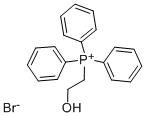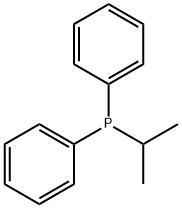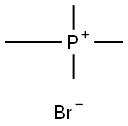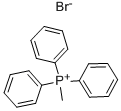CYCLOPROPYLTRIPHENYLPHOSPHONIUM BROMIDE
Synonym(s):NSC 110599
- CAS NO.:14114-05-7
- Empirical Formula: C21H20BrP
- Molecular Weight: 383.26
- MDL number: MFCD00011872
- EINECS: 237-970-1
- SAFETY DATA SHEET (SDS)
- Update Date: 2023-04-23 13:52:06

What is CYCLOPROPYLTRIPHENYLPHOSPHONIUM BROMIDE?
Chemical properties
white to slightly yellowish crystalline powder
The Uses of CYCLOPROPYLTRIPHENYLPHOSPHONIUM BROMIDE
Cyclopropyltriphenylphosphonium bromide has cytotoxic activity against the growth of tissue culture cells originating from human epidermoid carcinoma of the nasopharynx (KB). It is commonly used as a Wittig reagent.
The Uses of CYCLOPROPYLTRIPHENYLPHOSPHONIUM BROMIDE
Used for electrolytic polarization of Zn
Studied for potential antitumor activity
Reactant for synthesis of:
- Keto halides for sequential azidation and intramolecular Schmidt reactions
- Cycloporpylidenemethylarylethynynes
- Dipeptides containing azabicyclo[3.1.0]hexane
Reactant for hydroalkynylation
What are the applications of Application
Cyclopropyltriphenylphosphonium bromide is a Wittig reagent.
Properties of CYCLOPROPYLTRIPHENYLPHOSPHONIUM BROMIDE
| Melting point: | 178-181 °C(lit.) |
| storage temp. | Inert atmosphere,Room Temperature |
| form | solid |
| color | White to Almost white |
| Water Solubility | Soluble in water. |
| Sensitive | Hygroscopic |
| BRN | 6413483 |
| CAS DataBase Reference | 14114-05-7(CAS DataBase Reference) |
Safety information for CYCLOPROPYLTRIPHENYLPHOSPHONIUM BROMIDE
| Signal word | Warning |
| Pictogram(s) |
 Exclamation Mark Irritant GHS07 |
| GHS Hazard Statements |
H315:Skin corrosion/irritation H319:Serious eye damage/eye irritation H335:Specific target organ toxicity, single exposure;Respiratory tract irritation |
| Precautionary Statement Codes |
P261:Avoid breathing dust/fume/gas/mist/vapours/spray. P264:Wash hands thoroughly after handling. P264:Wash skin thouroughly after handling. P280:Wear protective gloves/protective clothing/eye protection/face protection. P304+P340:IF INHALED: Remove victim to fresh air and Keep at rest in a position comfortable for breathing. P305+P351+P338:IF IN EYES: Rinse cautiously with water for several minutes. Remove contact lenses, if present and easy to do. Continuerinsing. P405:Store locked up. |
Computed Descriptors for CYCLOPROPYLTRIPHENYLPHOSPHONIUM BROMIDE
| InChIKey | XMPWFKHMCNRJCL-UHFFFAOYSA-M |
New Products
4-Aminotetrahydropyran-4-carbonitrile Hydrochloride (R)-3-Aminobutanenitrile Hydrochloride 4-AMINO-TETRAHYDRO-PYRAN-4-CARBOXYLIC ACID HCL 4-(Dimethylamino)tetrahydro-2H-pyran-4-carbonitrile 3-((Dimethylamino)methyl)-5-methylhexan-2-one oxalate 1,4-Dioxa-8-azaspiro[4.5]decane 5-Bromo-2-nitropyridine Nimesulide BP Aceclofenac IP/BP/EP Mefenamic Acid IP/BP/EP/USP Diclofenac Sodium IP/BP/EP/USP Ornidazole IP Diclofenac Potassium SODIUM AAS SOLUTION ZINC AAS SOLUTION BUFFER SOLUTION PH 10.0(BORATE) GOOCH CRUCIBLE SINTERED AQUANIL 5 BERYLLIUM AAS SOLUTION 2-Bromo-1-(bromomethyl)-3-chloro-5-nitrobenzene 2-Bromo-3-nitroaniline N-(3-Hydroxypropyl)-N-methylacetamide 3-Bromo-6-chloropyridazine 4-ethyl-3-nitrobenzoic acidRelated products of tetrahydrofuran








You may like
-
 Cyclopropyltriphenylphosphonium Bromide CAS 14114-05-7View Details
Cyclopropyltriphenylphosphonium Bromide CAS 14114-05-7View Details
14114-05-7 -
 Cyclopropyltriphenylphosphonium bromide CAS 14114-05-7View Details
Cyclopropyltriphenylphosphonium bromide CAS 14114-05-7View Details
14114-05-7 -
 1823368-42-8 98%View Details
1823368-42-8 98%View Details
1823368-42-8 -
 2-(3-(tert-butyl)phenoxy)-2-methylpropanoic acid 1307449-08-6 98%View Details
2-(3-(tert-butyl)phenoxy)-2-methylpropanoic acid 1307449-08-6 98%View Details
1307449-08-6 -
 Ethyl 3-(furan-2-yl)-3-hydroxypropanoate 25408-95-1 98%View Details
Ethyl 3-(furan-2-yl)-3-hydroxypropanoate 25408-95-1 98%View Details
25408-95-1 -
 2-Chloro-5-fluoro-1-methoxy-3-methylbenzene 98%View Details
2-Chloro-5-fluoro-1-methoxy-3-methylbenzene 98%View Details
1805639-70-6 -
 1784294-80-9 98%View Details
1784294-80-9 98%View Details
1784294-80-9 -
 Lithium ClavulanateView Details
Lithium ClavulanateView Details
61177-44-4
Statement: All products displayed on this website are only used for non medical purposes such as industrial applications or scientific research, and cannot be used for clinical diagnosis or treatment of humans or animals. They are not medicinal or edible.